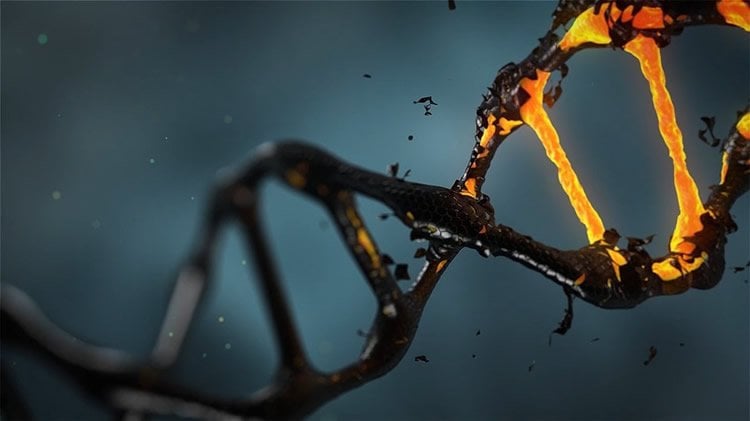Summary: Researchers have identified three regions in the genome where significant genetic differences between the sexes exist. These differences also varied by cancer type. The findings suggest specific genetic tests tailored to the different sexes could help assess cancer risks.
Source: Case Western Reserve.
Glioma is the most common type of primary malignant brain tumor in the United States; glioblastoma being the most common type of glioma in adults. While sex differences in the incidence and survival rates of glioma were known, researchers had not investigated whether genetic differences based on sex could cast light on potential differences in the risk profile of glioma between men and women.
Now, a team from Case Western Reserve University School of Medicine, together with an international consortium of researchers, have discovered that men and women have different genetic risk factors for developing glioma.
The research was recently published in Scientific Reports. The study involved the work of more than 35 investigators representing more than 30 universities, institutes and government agencies worldwide.
“Sex-stratified analyses in studies such as this can reveal novel insights into the known sex differences in glioma and provide previously unknown genetic risk associations,” said Jill Barnholtz-Sloan, Sally S. Morley Designated Professor in Brain Tumor Research at Case Western Reserve University School of Medicine, Associate Director for Bioinformatics at Case Comprehensive Cancer Center, and Associate Director for Translational Informatics at the Institute for Computational Biology. “This finding could provide an avenue to gaining a better understanding of sex differences in brain tumor incidence, and may also suggest varying mechanisms and pathways of the disease.”
The consortium looked at the genetic differences among all glioma, glioblastoma only and non-glioblastoma patients based on their sex. Quinn Ostrom, PhD, came up with the idea for the study while she was a graduate assistant for Barnholtz-Sloan. Ostrom now is doing post-doctoral work in cancer epidemiology at Baylor College of Medicine in Houston, Texas.

The researchers found three regions in the genome where significant genetic differences between men and women existed, and these differences also varied by sex and type of tumor (glioblastoma vs. non-glioblastoma). “There’s one where it’s clearly associated with an increased risk in males, one where it’s clearly associated with an increased risk in females, and one where it’s showing in both males and females, but it seems to have a stronger association in females,” Barnholtz-Sloan said.
Though early in the process of understanding the genetic sources of sex based differences in malignant brain tumors, the recent analysis could help define a path to a genetic test that helps doctors assess patient risk for brain cancer.
“We were surprised to find a large region in the genome associated with glioma and specifically glioblastoma in females only,” Barnholtz-Sloan said. “This region had not previously been associated with gliomas, although other similar genome-wide associated studies have identified associations at this region for a variety of traits, including several autoimmune diseases, as well as increased age at menarche.” As the study discussion notes, if increased lifetime estrogen exposure decreases glioma risk, as some have hypothesized, it is possible that variants which increase age at menarche (potentially decreasing total estrogen exposure) may increase glioma risk in females.
Funding: Cancer Prevention and Research Institute of Texas, National Institutes of Health, McNair Medical Institute and the Population Sciences Biorepository at Baylor College of Medicine funded this study.
Source: Ansley Gogol – Case Western Reserve
Publisher: Organized by NeuroscienceNews.com.
Image Source: NeuroscienceNews.com image is in the public domain.
Original Research: Open access research for “Sex-specific glioma genome-wide association study identifies new risk locus at 3p21.31 in females, and finds sex-differences in risk at 8q24.21” by Quinn T. Ostrom, Ben Kinnersley, Margaret R. Wrensch, Jeanette E. Eckel-Passow, Georgina Armstrong, Terri Rice, Yanwen Chen, John K. Wiencke, Lucie S. McCoy, Helen M. Hansen, Christopher I. Amos, Jonine L. Bernstein, Elizabeth B. Claus, Dora Il’yasova, Christoffer Johansen, Daniel H. Lachance, Rose K. Lai, Ryan T. Merrell, Sara H. Olson, Siegal Sadetzki, Joellen M. Schildkraut, Sanjay Shete, Joshua B. Rubin, Justin D. Lathia, Michael E. Berens, Ulrika Andersson, Preetha Rajaraman, Stephen J. Chanock, Martha S. Linet, Zhaoming Wang, Meredith Yeager, GliomaScan consortium, Richard S. Houlston, Robert B. Jenkins, Beatrice Melin, Melissa L. Bondy & Jill. S. Barnholtz-Sloan in Scientific Reports. Published May 9 2018.
doi:10.1038/s41598-018-24580-z
[cbtabs][cbtab title=”MLA”]Case Western Reserve”Men and Women Have Different Genetic Risk Factors for Developing Brain Cancer.” NeuroscienceNews. NeuroscienceNews, 1 July 2018.
<https://neurosciencenews.com/sex-genetics-brain-cancer-9491/>.[/cbtab][cbtab title=”APA”]Case Western Reserve(2018, July 1). Men and Women Have Different Genetic Risk Factors for Developing Brain Cancer. NeuroscienceNews. Retrieved July 1, 2018 from https://neurosciencenews.com/sex-genetics-brain-cancer-9491/[/cbtab][cbtab title=”Chicago”]Case Western Reserve”Men and Women Have Different Genetic Risk Factors for Developing Brain Cancer.” https://neurosciencenews.com/sex-genetics-brain-cancer-9491/ (accessed July 1, 2018).[/cbtab][/cbtabs]
Abstract
Sex-specific glioma genome-wide association study identifies new risk locus at 3p21.31 in females, and finds sex-differences in risk at 8q24.21
Incidence of glioma is approximately 50% higher in males. Previous analyses have examined exposures related to sex hormones in women as potential protective factors for these tumors, with inconsistent results. Previous glioma genome-wide association studies (GWAS) have not stratified by sex. Potential sex-specific genetic effects were assessed in autosomal SNPs and sex chromosome variants for all glioma, GBM and non-GBM patients using data from four previous glioma GWAS. Datasets were analyzed using sex-stratified logistic regression models and combined using meta-analysis. There were 4,831 male cases, 5,216 male controls, 3,206 female cases and 5,470 female controls. A significant association was detected at rs11979158 (7p11.2) in males only. Association at rs55705857 (8q24.21) was stronger in females than in males. A large region on 3p21.31 was identified with significant association in females only. The identified differences in effect of risk variants do not fully explain the observed incidence difference in glioma by sex.







